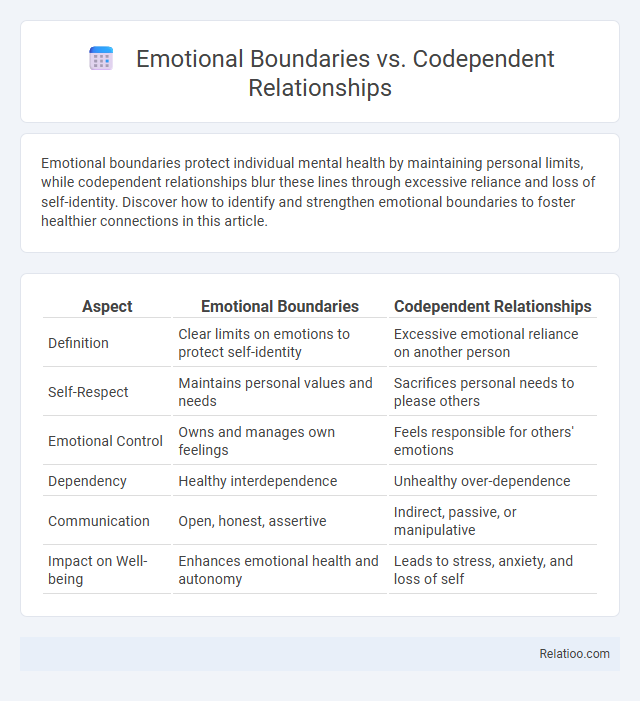Emotional boundaries protect individual mental health by maintaining personal limits, while codependent relationships blur these lines through excessive reliance and loss of self-identity. Discover how to identify and strengthen emotional boundaries to foster healthier connections in this article.
Table of Comparison
| Aspect | Emotional Boundaries | Codependent Relationships |
|---|---|---|
| Definition | Clear limits on emotions to protect self-identity | Excessive emotional reliance on another person |
| Self-Respect | Maintains personal values and needs | Sacrifices personal needs to please others |
| Emotional Control | Owns and manages own feelings | Feels responsible for others' emotions |
| Dependency | Healthy interdependence | Unhealthy over-dependence |
| Communication | Open, honest, assertive | Indirect, passive, or manipulative |
| Impact on Well-being | Enhances emotional health and autonomy | Leads to stress, anxiety, and loss of self |
Understanding Emotional Boundaries
Emotional boundaries define the limits that protect an individual's feelings and sense of self, distinguishing personal emotions from others' influences. Understanding emotional boundaries is crucial to preventing codependent relationships, where blurred lines lead to excessive reliance on another for validation or self-worth. Establishing and respecting these boundaries fosters emotional independence and healthier interpersonal dynamics.
Defining Codependent Relationships
Codependent relationships are characterized by an unhealthy reliance on one partner for emotional support and validation, leading to a loss of personal boundaries and self-identity. Emotional boundaries refer to the limits one sets to protect their emotional wellbeing, preventing excessive dependence on others. In contrast to codependency, healthy emotional boundaries promote mutual respect and autonomy within relationships.
Key Differences Between Healthy Boundaries and Codependency
Healthy emotional boundaries involve recognizing personal limits, maintaining self-respect, and fostering mutual respect in relationships, which supports individual autonomy and emotional well-being. Codependency, by contrast, features an excessive reliance on others for approval and identity, often leading to blurred boundaries, enabling behaviors, and emotional manipulation. The key difference lies in the balance of self-care and interpersonal connection, where healthy boundaries empower independence, while codependency undermines it through over-involvement and loss of self.
Signs You Lack Emotional Boundaries
Lacking emotional boundaries often manifests as an inability to say no, feelings of guilt when prioritizing your own needs, and excessive responsibility for others' emotions, which are key signs linked to codependency. In codependent relationships, these boundary issues create unhealthy attachments where your sense of self becomes enmeshed with another person's well-being. Recognizing these signs empowers you to establish healthier emotional limits and break free from codependent dynamics.
Common Traits of Codependent Dynamics
Codependent relationships often exhibit emotional boundaries that are blurred or nonexistent, leading to an excessive reliance on others for validation and self-worth. Common traits include a strong need to please, difficulty expressing personal needs, and an overwhelming sense of responsibility for others' emotions or problems. These dynamics foster imbalance, making it challenging to maintain individual identity and healthy interpersonal connections.
The Impact of Poor Boundaries on Emotional Well-being
Poor emotional boundaries often lead to codependent relationships, where individuals excessively rely on each other for emotional validation, resulting in diminished self-esteem and increased anxiety. Codependency fosters unhealthy patterns of enabling and neglecting personal needs, severely impacting emotional well-being by creating chronic stress and emotional exhaustion. Establishing clear emotional boundaries is essential for maintaining mental health, promoting autonomy, and preventing the detrimental effects of codependency.
How Codependency Damages Relationships
Codependency damages relationships by fostering unhealthy emotional boundaries, where one person's identity and self-worth become overly tied to another's needs and approval. This dynamic leads to imbalanced give-and-take, emotional exhaustion, and loss of personal autonomy. Understanding how your boundaries are compromised helps break the cycle of codependency and rebuild healthier connections.
Setting and Maintaining Healthy Emotional Boundaries
Setting and maintaining healthy emotional boundaries is essential for distinguishing between emotional boundaries, codependent relationships, and codependency. Emotional boundaries help you protect your emotional well-being by clearly defining where your feelings end and others' begin, preventing unhealthy enmeshment often seen in codependency. Establishing these boundaries fosters mutual respect and autonomy, reducing the risk of falling into codependent patterns that undermine your emotional health.
Overcoming Codependency: Steps Toward Independence
Establishing strong emotional boundaries is crucial for overcoming codependency and fostering independence in relationships. Recognizing patterns of codependent behavior, such as excessive caregiving and reliance on others for self-worth, allows individuals to reclaim autonomy and develop self-care practices. Healing involves setting clear limits, prioritizing personal needs, and seeking support through therapy or support groups to reinforce self-identity and emotional resilience.
Building Healthy, Balanced Relationships
Building healthy, balanced relationships requires setting clear emotional boundaries to protect your well-being while fostering mutual respect. Codependent relationships often blur these boundaries, leading to unhealthy dependence and loss of individual identity. Understanding the signs of codependency empowers you to establish empowering limits that nurture both personal growth and relational harmony.

Infographic: Emotional Boundaries vs Codependent Relationships
 relatioo.com
relatioo.com